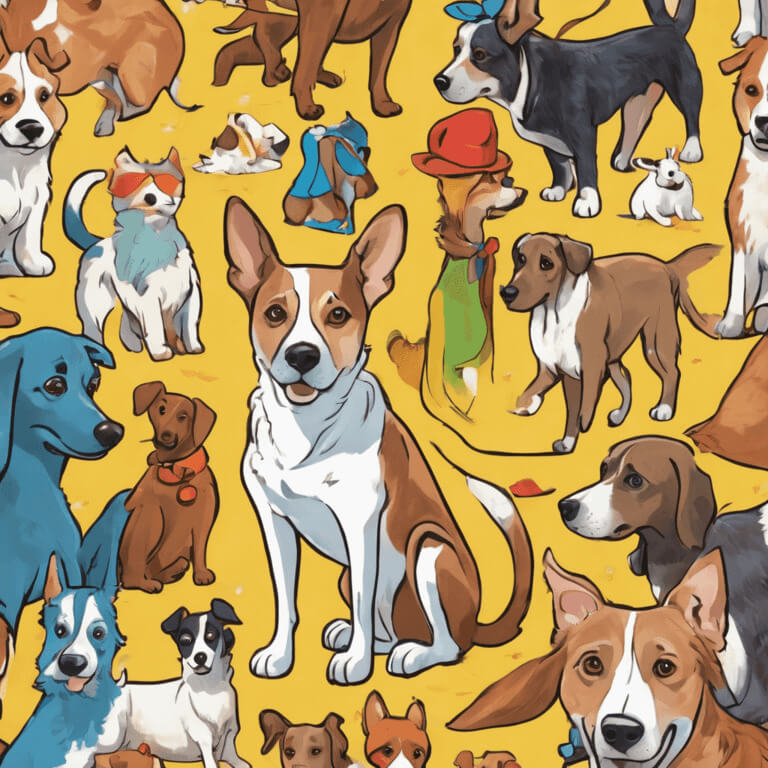
Dogs are incredible companions, each with its unique personalities and characteristics. To truly connect with your furry friend, it’s essential to understand these traits and how they shape your dog’s behavior. In our comprehensive guide, “The Ultimate Guide to Understanding Your Dog,” we delve into 13 key canine traits, from sensitivity and friendliness to grooming needs and exercise requirements.
This guide provides you with valuable insights into your dog’s world, helping you build a stronger, more rewarding relationship with your four-legged family member. Explore our table of contents to embark on a journey of discovery, uncovering the nuances that make your dog an extraordinary companion.
Dog Sensitivity Levels
1. Low-Sensitive Dogs (Level 1): Low-sensitive dogs, also known as “tolerant” dogs, tend to have a calm and easygoing disposition. They are less likely to be deeply affected by their owner’s actions or external stimuli. These dogs can handle changes, loud noises, and even occasional neglect with a steady demeanor (BUT! they still benefit from consistent social interaction and companionship, as complete neglect can impact any dog’s well-being.). They are a good choice for people with busy lifestyles, young children, or those who may not always be able to provide constant attention.
2. Mildly Sensitive Dogs (Level 2): Dogs at this level are moderately sensitive. While they are generally tolerant, they may occasionally react to loud noises or certain stimuli, but their reactions are not extreme. They adapt well to various situations and can thrive in different environments.
3. Moderately Sensitive Dogs (Level 3): Dogs with moderate sensitivity have a balanced temperament. They can be responsive to their owner’s emotions and actions but are not overly reactive. These dogs usually require consistent training and socialization to help them handle various situations comfortably.
4. Sensitive Dogs (Level 4): Sensitive dogs are quite responsive to their environment and their owner’s actions. They can be deeply affected by loud voices, neglect, or any abrupt changes in their routine. These dogs benefit from a structured environment, positive reinforcement training, and a patient owner.
5. High-Sensitive Dogs (Level 5): High-sensitivity dogs are the most emotionally responsive. They may take their owner’s actions very seriously and can be easily distressed by shouting, neglect, or abrupt changes. These dogs thrive in calm and consistent environments, with owners who can provide gentle guidance and reassurance.
table of content ↑Kid-Friendliness Levels in Dogs
1. Not Kid-Friendly Dogs (Level 1): Dogs in this category do not tolerate children’s behavior well. They may react negatively or even aggressively when subjected to actions like hugs, attempts to saddle them, or other playful “games.” It’s essential to be extremely cautious when considering a not kid-friendly dog in a family setting. These dogs may be better suited to households without children or with older, dog-savvy kids.
2. Low Kid-Friendly Dogs (Level 2): Dogs at this level have limited tolerance for children’s behavior. They may not appreciate hugs or rough play and could react with discomfort or mild aggression. While some training and socialization can help, they may still be better suited to families with older children who understand how to interact with dogs respectfully.
3. Moderately Kid-Friendly Dogs (Level 3): Dogs with moderate kid-friendliness can tolerate children’s behavior to some extent. They may be more patient and forgiving but may still have limits. Proper training and supervision are crucial to ensure a positive interaction between these dogs and children.
4. Kid-Friendly Dogs (Level 4): These dogs are generally comfortable with children’s behavior and tend to be patient and gentle. They can handle hugs and playful antics with ease. However, supervision is always important, especially when very young children are involved.
5. Highly Kid-Friendly Dogs (Level 5): Highly kid-friendly dogs are exceptionally tolerant and loving towards children. They not only tolerate hugs and playful games but actively enjoy them. These dogs often seek out the company of children and can be trusted companions in family environments.
It’s essential to consider your family’s specific needs and the ages of your children when choosing a dog with regard to their kid-friendliness level. Even the most kid-friendly dogs should be supervised when interacting with young children to ensure a safe and positive experience for both the dog and the child.
table of content ↑Dog Friendliness Spectrum
1. Low-Friendly Dogs (Level 1): Dogs in this category are less inclined to be sociable with other dogs. They might display behaviors such as barking, growling, or attempting to engage in fights with other dogs. They may also try to avoid unfamiliar dogs or situations. Low-friendly dogs may require extra training and socialization to improve their comfort around other canines.
2. Moderately Low-Friendly Dogs (Level 2): Dogs at this level are somewhat reserved around other dogs. While they may not actively seek conflict, they can display discomfort or unease in the presence of unfamiliar dogs. Adequate training and controlled introductions can help manage their interactions with other canines.
3. Moderately Friendly Dogs (Level 3): Dogs with moderate friendliness are generally comfortable around other dogs but may not actively seek out social interactions. They are less likely to initiate play but will tolerate the presence of other dogs and engage in it when invited. Proper socialization can help enhance their social skills.
4. Friendly Dogs (Level 4): Friendly dogs are sociable and enjoy interacting with other dogs. They may happily play and engage with unfamiliar canines, displaying a calm and relaxed demeanor. They are well-suited for dog parks and group playdates.
5. Highly Friendly Dogs (Level 5): Highly friendly dogs are exceptionally sociable and seek out the company of other dogs. They actively enjoy playing and socializing with unfamiliar canines. These dogs are often excellent candidates for multi-dog households or environments with frequent canine interactions.
It’s important to remember that a dog’s friendliness level is influenced by various factors, including their individual personality, upbringing, and experiences. While breed can provide some insight, it’s not the sole determining factor. Regardless of a dog’s friendliness level, responsible dog owners should provide proper training and supervision during interactions with other dogs to ensure positive experiences for all parties involved.
table of content ↑Stranger-Friendliness Levels in Dogs
1. Low-Friendly Dogs (Level 1): Dogs at this level tend to be wary or even fearful of strangers. They may display signs of aggression, such as barking, growling, or attempting to keep strangers at a distance. Proper socialization and training are essential to help these dogs become more comfortable around unfamiliar people.
2. Moderately Low-Friendly Dogs (Level 2): Dogs in this category are cautious around strangers but may not exhibit overt aggression. They may show signs of unease, such as avoiding eye contact or keeping their distance. With gradual exposure and positive experiences, they can become more accepting of strangers.
3. Moderately Friendly Dogs (Level 3): Dogs with moderate stranger-friendliness are generally open to meeting new people but may not actively seek out interactions. They are typically polite and may wag their tails or sniff strangers, but they won’t be overly enthusiastic. Proper socialization can enhance their comfort around unfamiliar individuals.
4. Friendly Dogs (Level 4): Friendly dogs are sociable and open to strangers. They often exhibit a welcoming demeanor when meeting new people, such as wagging their tails, approaching with curiosity, and displaying relaxed body language. These dogs are usually comfortable with guests in your home.
5. Highly Friendly Dogs (Level 5): Highly friendly dogs are exceptionally welcoming to strangers. They actively seek out interactions and are delighted to meet new people. They may enthusiastically greet strangers, inviting petting and play. These dogs are typically very well-suited for social environments.
It’s crucial to remember that a dog’s behavior toward strangers is influenced by multiple factors, including breed tendencies, socialization, and individual personality. While some breeds may have a natural inclination toward friendliness, proper training and positive experiences play a significant role in shaping a dog’s behavior. Responsible dog owners should consider these factors when assessing their dog’s behavior toward strangers and take steps to ensure positive interactions.
table of content ↑Shedding in Dogs
Level 1 – Low: Dogs in this category have minimal shedding, and their hair is not a significant concern. They are ideal for individuals who prefer a clean and hair-free environment.
Level 2 – Moderately Low: Dogs with moderately low shedding levels may shed a small amount, usually during specific seasons. While it’s manageable, occasional grooming and cleaning are required to maintain a tidy home.
Level 3 – Moderate Shedding: Dogs in this category have moderate shedding, which may occur throughout the year or during specific seasons. They shed a moderate amount, and regular grooming and cleaning help manage the hair.
Level 4 – High Shedding: Dogs with high shedding levels shed consistently and can leave a noticeable amount of hair around your home. They require frequent grooming and cleaning, making them better suited for individuals willing to manage the shedding.
Level 5 – High: Dogs in this category have exceptionally high shedding levels, and shedding is a significant concern. They may leave a substantial amount of hair, and frequent grooming and cleaning are essential to keep the environment tidy. These dogs are best for owners who are prepared to manage significant shedding.
table of content ↑Grooming Needs in Dogs
Level 1 – Easy: Dogs in this category have the lowest grooming needs. They typically have short, low-shedding coats that require minimal maintenance, including occasional brushing and straightforward grooming. These dogs are an excellent choice for those who prefer a hassle-free grooming routine.
Level 2 – Moderately Easy: Dogs at this level have low grooming needs. Their short coats are easy to manage and require only occasional brushing and basic grooming tasks like nail trimming. Owners can comfortably handle their grooming needs at home.
Level 3 – Moderate: Dogs with moderate grooming needs have coats that are relatively easy to maintain. They may require regular brushing and occasional baths, but grooming sessions are usually straightforward and not too time-consuming. Owners of dogs in this category can manage their grooming needs without much difficulty.
Level 4 – Moderately Hard: Dogs at this level have grooming needs that are moderately challenging. They may have medium-length coats that need regular brushing, occasional clipping, and grooming. While grooming is essential, it’s not as time-consuming or expensive as with hard grooming dogs.
Level 5 – Hard: Dogs in this category have the highest grooming needs. They typically have long, thick coats that require regular brushing, clipping, and professional grooming services. Owners of hard grooming dogs should be prepared for time-consuming grooming appointments and invest in the necessary grooming tools.
table of content ↑Overall Health in Dogs
Level 1 – Need more attention to health: Dogs in this category may have a higher likelihood of genetic health problems due to irresponsible breeding practices. These dogs may require more proactive and regular veterinary care and may be at greater risk of developing health issues. It’s essential to be aware of potential genetic illnesses associated with their breed and take steps to monitor and maintain their health.
Level 2 – Below Average Health: Dogs with below-average health may have some genetic health concerns, and they might need more attention to their well-being. Regular veterinary check-ups and monitoring of potential genetic issues are important to keep them as healthy as possible.
Level 3 – Moderate Health: Dogs in this category have average general health. They are generally healthy but may require regular veterinary care, vaccinations, and preventative measures to ensure their well-being. Keeping up with their health needs is important.
Level 4 – Above Average Health: Dogs with above-average health are relatively healthy and may have a lower risk of genetic health issues. While they still require regular veterinary care, they are less prone to illness and may lead a healthy and active life with proper care.
Level 5 – Healthy as an ox: Dogs in this category are exceptionally healthy with a low risk of genetic health problems. They typically require standard veterinary care, but they are robust and resilient, often leading long and healthy lives with proper attention to their well-being.
table of content ↑Trainability in Dogs
Level 1 – Self-Willed: Dogs in this category may be more self-willed and independent in their behavior. They might require more time and patience during training sessions, since they may not readily respond to commands. Training these dogs can be a bit more challenging, and they may need extra motivation to follow your instructions. However, don’t worry—patience and positive reinforcement are effective methods.
Level 2 – Moderately Independent: Dogs with moderate independence may not always be eager to please but are not overly self-willed. They can be trained with patience and consistent effort, although it may take more time and attention to establish a strong training routine.
Level 3 – Average Trainability: Dogs in this category have an average level of trainability. They are generally responsive to training but may require consistent practice and reinforcement of commands. With patience and a rewards-based approach, they can learn and adapt well.
Level 4 – Eager to Learn: Dogs with above-average trainability are enthusiastic about learning and cooperating. They readily respond to training and are motivated by rewards and positive interactions. They are quick to grasp commands and are a pleasure to train.
Level 5 – Eager to Please: Dogs in this category are highly eager to please their owners. They are exceptionally responsive to training and quickly understand and obey commands. These dogs thrive on positive feedback, rewards, and training sessions, making them easy to train and delightful companions.
table of content ↑Intelligence in Dogs
Level 1 – Low: Dogs in this category may have a simpler cognitive style, showing slower decision-making and a limited ability to learn complex tasks. They may not be as quick to understand commands and may require more straightforward training methods.
Level 2 – Below Average: Dogs with below-average intelligence may take more time to grasp commands and may not excel in tasks that require significant problem-solving. Training these dogs may require patience and repetition.
Level 3 – Average Intelligence: Dogs in this category have average intelligence. They can learn and respond to commands effectively, although it may take some practice and consistency in training. They can excel in typical obedience training and daily tasks.
Level 4 – Above Average: Dogs with above-average intelligence are quick learners and exhibit good problem-solving abilities. They can easily grasp new commands and may excel in tasks that require cognitive skills. These dogs benefit from mental stimulation and enrichment activities.
Level 5 – High: Dogs in this category have high intelligence, making them exceptional problem solvers and quick decision-makers. They are capable of advanced training, complex tasks, and excel in various activities that challenge their mental abilities. These dogs thrive on intellectual challenges and benefit from activities that stimulate their intelligence.
table of content ↑Vocalization Tendency in Dogs
Level 1 – Only to Alert: Dogs in this category typically bark or howl only when necessary, primarily to alert their owners to potential dangers or visitors. They are generally quiet and do not engage in excessive vocalization.
Level 2 – Occasionally Vocal: Dogs with occasional vocal tendencies may bark or howl on occasion but not excessively. They are responsive to specific situations, such as visitors or unusual sounds, and do not create constant noise.
Level 3 – Moderate Vocalization: Dogs in this category may engage in moderate vocalization, barking or howling in response to various stimuli like strangers, wildlife, or noises. While not excessively vocal, they are more likely to express themselves audibly.
Level 4 – Quite Vocal: Dogs that are quite vocal tend to bark or howl frequently, often in response to various situations and stimuli. They may create a fair amount of noise, which may not be suitable for noise-sensitive environments.
Level 5 – Avid Singer: Dogs in this category are avid singers and are highly vocal. They bark or howl regularly and may do so for various reasons, including excitement, communication, or in response to their surroundings. They are known for their expressive vocalizations and may not be suitable for quiet or noise-restricted environments.
table of content ↑Energy Level in Dogs
Level 1 – Low: Dogs in this category have a low energy level and prefer a more relaxed and sedentary lifestyle. They enjoy lounging, napping, and are content to be by your side while you relax.
Level 2 – Moderately Low: Dogs with moderately low energy levels are relatively low-key but may occasionally engage in short bursts of play and activity. They are not highly active and are happy with a moderately calm daily routine.
Level 3 – Moderate Energy: Dogs in this category have moderate energy levels. They enjoy regular playtime, walks, and activities but also appreciate downtime. They can adapt to a balanced mix of exercise and relaxation.
Level 4 – Energetic: Energetic dogs are quite active and thrive on exercise and play. They require regular physical activity and mental stimulation to remain content. They enjoy play, running, and exploring.
Level 5 – High: Dogs with a high energy level are exceptionally active and enthusiastic. They are always ready for play, running, and adventure. They may require frequent and intense exercise to keep them happy and healthy.
table of content ↑Exercise Needs in Dogs
Level 1 – Low: Dogs in this category have low exercise needs and are content with short, leisurely walks and minimal physical activity. They enjoy a more sedentary lifestyle and are suitable for individuals with limited mobility or those who prefer a calmer routine.
Level 2 – Moderately Low: Dogs with moderately low exercise needs require occasional play and short walks but don’t demand vigorous exercise. They are well-suited for individuals with a moderately active lifestyle and those who prefer a balanced daily routine.
Level 3 – Moderate Exercise: Dogs in this category have moderate exercise needs and benefit from regular play, walks, and activities. They thrive with a balanced mix of physical and mental stimulation and are suitable for individuals with an active lifestyle.
Level 4 – Energetic: Energetic dogs have high exercise needs and require regular and vigorous physical activity. They enjoy activities such as play, running, and outdoor adventures. They are ideal for individuals who are active and love outdoor pursuits.
Level 5 – High: Dogs with high exercise needs are exceptionally active and demand a significant amount of exercise and mental stimulation. They thrive with intense physical activities, such as running, agility, or dog sports. They are best suited for individuals who are highly active and committed to providing ample exercise opportunities.
table of content ↑Playfulness Potential in Dogs
Level 1 – Low: Dogs in this category have low potential for playfulness and tend to be more serious and reserved. They may prefer downtime and relaxation over playtime and are suitable for individuals seeking a calm and quiet companion.
Level 2 – Moderately Low: Dogs with moderately low playfulness potential may engage in occasional play but are generally more reserved. They appreciate relaxation but can enjoy brief playtime sessions. They are ideal for individuals who seek a balance between play and calm moments.
Level 3 – Moderate Playfulness: Dogs in this category have moderate potential for playfulness. They enjoy regular playtime and interactions but also appreciate rest. They are suitable for individuals who want a playful companion without excessive energy.
Level 4 – Playful: Playful dogs have high potential for playfulness and are always up for play. They stay in a playful state of mind and eagerly engage in activities and games. They are great companions for individuals seeking an active and playful pet.
Level 5 – High: Dogs with high potential for playfulness are exceptionally playful and exuberant. They are in a constant state of play and enthusiastically seek interactions and activities. They are best for individuals who are excited about a highly playful and energetic companion.
table of content ↑Insights
- Tailoring Your Approach: By knowing your dog’s sensitivity level, you can tailor your training methods to ensure a positive and stress-free learning experience.
- Family Dynamics: Understanding your dog’s kid-friendliness and dog friendliness can help create a safe and enjoyable environment for everyone in your household.
- Socialization Matters: A dog’s friendliness toward strangers can often be shaped through proper socialization and training, transcending breed tendencies.
- Maintenance Considerations: Dogs with varying grooming needs require different levels of commitment and care. Matching your dog’s grooming needs to your lifestyle is essential.
- Wellness and Prevention: Recognizing your dog’s overall health condition is crucial for preventive care and maintaining a happy and active life.
- Learning Styles: A dog’s trainability and intelligence level impact the way they learn. Adapt your training methods to their unique cognitive abilities.
- Vocalization Habits: Understanding your dog’s tendency to bark or howl helps address noise concerns and keeps both your pet and your neighbors happy.
- Activity Levels: Matching your dog’s energy and exercise needs with your lifestyle ensures a balanced and satisfying life for both of you.
- Playful Companionship: Dogs’ potential for playfulness can greatly influence the quality of your interaction and shared activities.
Conclusion
This guide empowers you to see your dog in a new light, fostering a deeper connection and a more enjoyable journey together. Your four-legged friend has many stories to tell, and with the knowledge gained from this guide, you’ll be better equipped to listen, understand, and create beautiful memories for years to come.




